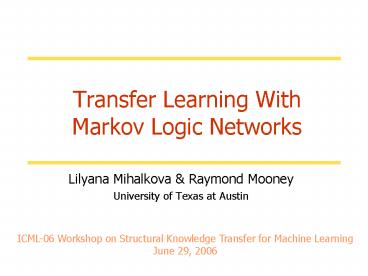Transfer Learning With Markov Logic Networks - PowerPoint PPT Presentation
1 / 19
Title:
Transfer Learning With Markov Logic Networks
Description:
Refinements to a clause are generated by. Adding a literal in all possible ways. Trying all possible literal deletions (only from clauses of the original source MLN) ... – PowerPoint PPT presentation
Number of Views:31
Avg rating:3.0/5.0
Title: Transfer Learning With Markov Logic Networks
1
Transfer Learning With Markov Logic Networks
- Lilyana Mihalkova Raymond Mooney
- University of Texas at Austin
ICML-06 Workshop on Structural Knowledge Transfer
for Machine Learning June 29, 2006
2
Markov Logic Networks
Richardson Domingos 2006
- Set of first-order formulae, each with a weight
attached - Templates for constructing Markov networks, when
a set of constants is provided - Include a node for each grounding of each
predicate in the MLN - Include a feature for each grounding of each
formula in the MLN
3
MLNs Inference
Richardson Domingos 2006
- Given a set of unknown query ground literals Q
and a set of evidence ground literals E, find
P(QE) - Done using Gibbs sampling
4
MLNs Inference Cont.
Richardson Domingos 2006
- Recomputing P(XMBX) in basic Gibbs step
5
MLN Structure Learning
Kok Domingos 2005
- Can start from scratch or from provided MLN
- Proceeds by using greedy beam-search
- Refinements to a clause are generated by
- Adding a literal in all possible ways
- Trying all possible literal deletions (only from
clauses of the original source MLN) - Trying all possible sign flips of the literals
- Candidates are scored using a weighted pseudo
log-likelihood measure - The best b candidates are kept and in the next
iteration new refinements are generated from them
6
Setting and Assumptions
- Given
- MLN, S, learned in source relational domain
- Mapping between predicates in source and target
domains - Find out which parts of S are still valid in new
domain and which need to be relearned - Perform relearning of incorrect structure
7
Transfer Learning as Revision
- Regard source MLN as an incorrect model for the
target task that needs to be accurately and
efficiently revised - Thus our general approach is similar to that
taken by revision systems Richards Mooney,
1995 - Revisions are proposed in a bottom-up fashion
8
New Algorithm
Relational Data
Change in pseudo log-likelihood
9
Self-Diagnosis Preliminaries
- From the perspective of a particular ground
literal, a clause can be in one of four
diagnostic bins - Applies, good
- Applies, bad
- Does not apply, good
- Does not apply, bad
Student(Ann) !HasJob(Ann,J) Sleepy(Ann),
Sociable(Ann) InClass(Ann,C)
InClass(Ann,C) gt Student(Ann)
Sociable(Ann) gt !Student(Ann)
Too General
!Sleepy(Ann) gt !Student(Ann)
HasJob(Ann,J) gt Student(Ann)
Too Specific
10
Self-Diagnosis
- Perform Gibbs sampling with each predicate P in
turn serving as query - In addition to recomputing probability of each
ground literal, calculate bin memberships of
participating clauses
11
Structure Updates
- Using directed beam search
- Literal deletions attempted only from clauses
marked as too specific - Literal additions only to clauses determined to
be too general - Restrictions carry over to derivatives of
original clauses - Search space constrained by
- Limiting the clauses considered for updates
- Restricting the type of update allowed
12
Experiments Domains
Academic Industrial
13
Experiments Data
- Each training mega-example is a world
representing the domain - Consists of roughly 50-150 true ground literals
- Generated by fixing the values of some predicate
groundings and performing MAP inference over a
hand-crafted MLN to set the rest
14
Experiments Details
- Systems compared
- ScratchAlchemy Kok Domingos 2005
- TransferAlchemy Kok Domingos 2005
- TransferNew
- Metrics
- Conditional log likelihood (CLL)
- Area under the precision-recall curve (AUC)
- Running time
- Number of candidate clauses considered
- Test predicates SupervisedBy and Secretary
15
Results CLL
16
Results AUC
17
Results Running Time
TransferAlchemy
TransferNew
18
Results Number of Candidates
TransferAlchemy
TransferNew
19
Conclusions
- Presented new transfer learning algorithm that
- Explicitly takes advantage of similarities
between tasks - Focuses on relearning only incorrect portions of
the domain - Decreases both search space and running time








![Investigations on Automatic Behavior-based System Design [A Survey on] Hierarchical Reinforcement Learning PowerPoint PPT Presentation](https://s3.amazonaws.com/images.powershow.com/6219810.th0.jpg?_=20150306026)






















